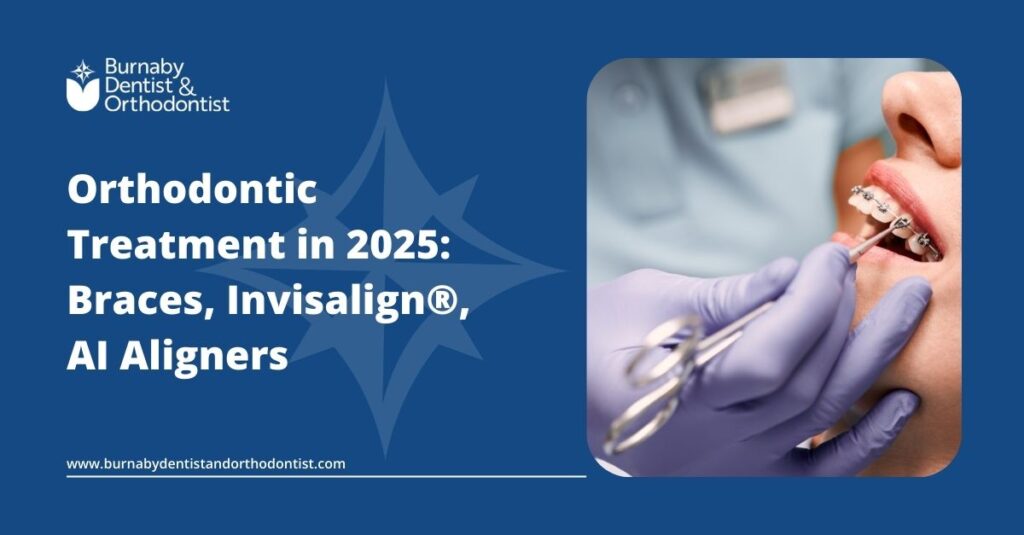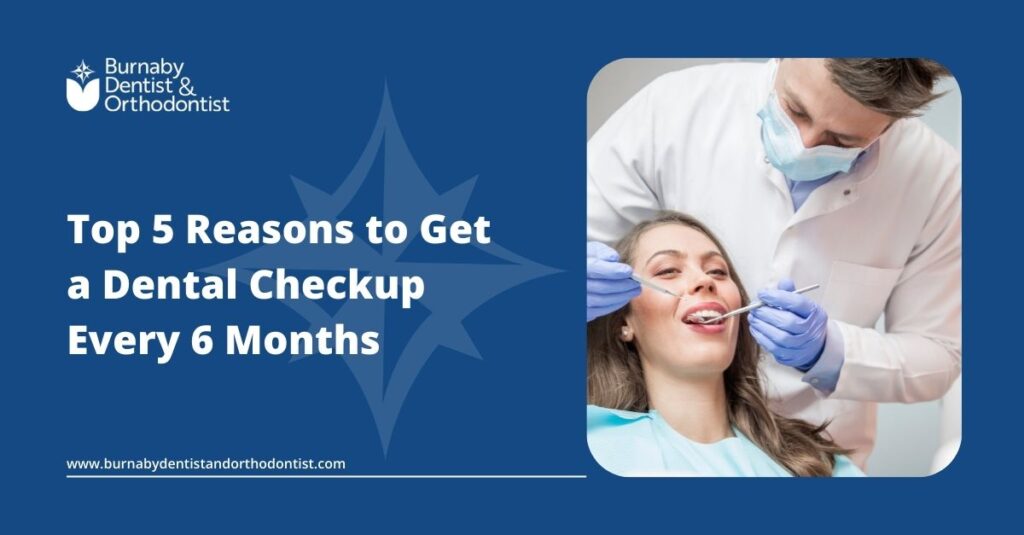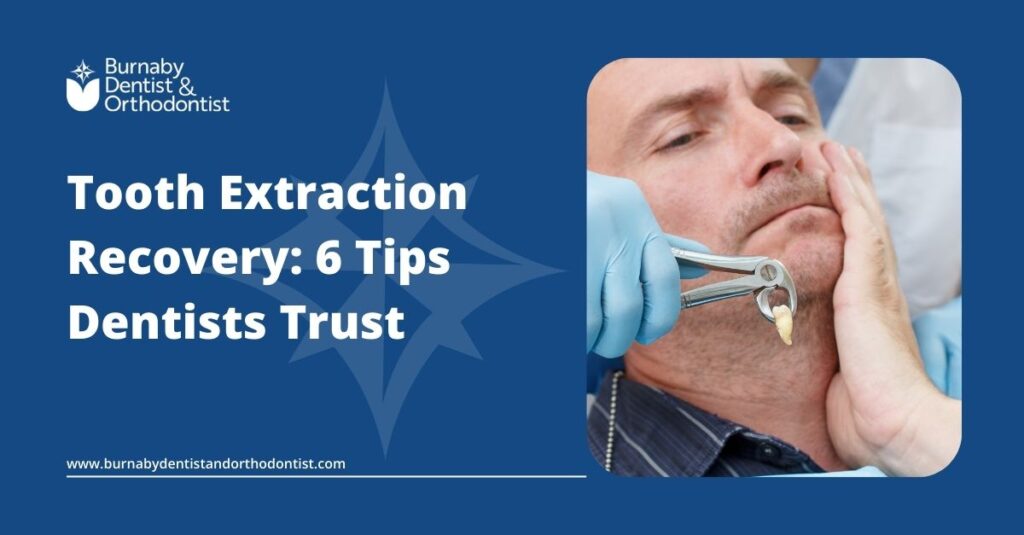Losing a front tooth changes more than just your appearance. It can affect the way you speak, eat, and interact with others. While dental implants are a popular solution, they aren’t the only path to restoring a complete, confident smile.
For many adults in Burnaby and Vancouver, a front-tooth dental bridge provides a natural-looking, non-surgical alternative with faster results.
This guide walks you through what the process looks like—from initial planning to final outcome—so you can make an informed decision with confidence.
At a Glance:
A front-tooth dental bridge offers a fast, natural-looking way to replace a missing tooth without surgery. It restores your appearance, bite function, and confidence—whether you choose a traditional, cantilever, Maryland, or implant-supported option. At Burnaby Dentist & Orthodontist, we use cosmetic planning to deliver bridges that blend in seamlessly and feel like your own teeth.
Why Front Teeth Require Special Consideration
Replacing a front tooth isn’t just about filling a gap—it’s about restoring the most visible and expressive part of your smile.
Front teeth play a key role in how you speak, eat, and present yourself. They’re also thinner than molars, positioned in a prominent location, and experience different types of pressure.
Because of this, front-tooth replacement demands precision in both function and aesthetics. A small mismatch in shape, shade, or bite alignment can stand out.
At Burnaby Dentist & Orthodontist, we take a comprehensive approach to ensure your bridge:
✔ Matches the natural colour and contour of your other teeth
✔ Allows you to speak clearly and comfortably
✔ Maintains proper bite alignment and tooth spacing
✔ Holds up under everyday use, including subtle motion from speaking and chewing
How a Dental Bridge Replaces a Missing Front Tooth
When a front tooth is missing, a dental bridge offers a stable, non-surgical way to restore both appearance and function. It closes the gap using a lifelike replacement tooth, held in place by neighbouring teeth.
A dental bridge is made up of:
Abutment Teeth: The healthy teeth on either side of the gap, typically fitted with crowns to support the bridge.
Pontic: The replacement tooth that fills the space and completes your smile.
Bridge Unit: The full structure, cemented securely to the abutments for a strong, natural-looking result.
There’s no implant post or surgical recovery involved. Instead, we use precision planning and high-strength materials to ensure a comfortable fit and seamless appearance.
At Burnaby Dentist & Orthodontist, we craft each front-tooth bridge to match the surrounding teeth in shade, shape, and symmetry—so it blends in perfectly, while restoring your ability to bite, speak, and smile without hesitation.
Types of Dental Bridges for Front Teeth: Choosing the Right Fit for Your Smile
Not every front-tooth gap requires the same solution. The best bridge depends on your dental structure, cosmetic goals, and how much support your neighbouring teeth can offer.
Here’s a breakdown of the most common types of front-tooth bridges—and how to choose the one that fits your needs:
| Comparison Table: Dental Bridge Types for Front Teeth | ||||
| Type | Structure | Best For | Pros | Considerations |
| Traditional Bridge | Pontic With Crowns On Both Sides | Gap With Two Strong Adjacent Teeth | Strong, Natural Appearance | Requires Reshaping Both Neighbouring Teeth |
| Cantilever Bridge | Pontic With Crown On One Side | Gap with Only One Adjacent Tooth | Conservative Prep, Simple Placement | Places More Force on a Single Tooth |
| Maryland Bridge | Pontic Bonded With Metal Or Ceramic Wings | Budget-Friendly or Low-Prep Cases | Minimal Tooth Alteration | Less Durable; May Need Rebonding |
| Implant Bridge | Pontic Supported by Implants | Multiple Missing Teeth, Weak Abutments | No Impact on Healthy Teeth | Requires Surgery, Longer Healing Time |
Traditional Dental Bridge
Ideal when both teeth beside the gap are healthy and strong. The bridge is anchored by crowns placed on each adjacent tooth. It offers stability and a highly natural look—but requires prepping the supporting teeth.
Cantilever Bridge
Used when there’s only one suitable tooth next to the gap—common for lateral incisor replacements. This type conserves more healthy tooth structure, but places added pressure on the single supporting tooth.
Maryland (Resin-Bonded) Bridge
A conservative, non-invasive solution, this bridge uses bonded “wings” behind neighbouring teeth to hold the false tooth. It’s best for temporary or budget-conscious cases and may need occasional rebonding due to lower strength.
Implant-Supported Bridge (Hybrid)
Recommended when multiple front teeth are missing or when the nearby teeth aren’t strong enough to support a traditional bridge. Anchored directly into the jaw with dental implants, it’s durable, functional, and preserves bone—but does involve surgery and longer treatment time.
Bridge vs. Implant: Which Works Best for the Front?
If you’re missing a front tooth, the two most common options are a dental bridge or a dental implant. Both restore appearance and function, but they work differently—and choosing the right one depends on your goals, bone health, and treatment preferences.
Here’s how the two compare:
| Comparison Table: Bridge vs. Implant | ||
| Factor | Dental Bridge | Dental Implant |
| Surgery Required | No | Yes (Minimally Invasive, Guided Placement) |
| Aesthetics | Highly Aesthetic, Especially for Custom Front Designs | Also Excellent — Mimics Both Root and Crown |
| Bone Preservation | Does Not Preserve Bone in the Gap Area | Actively Stimulates Bone to Prevent Loss |
| Impact on Adjacent Teeth | Requires Reshaping Neighbouring Teeth | Leaves Surrounded Teeth Untouched |
| Cost | Lower Upfront Cost | Higher Upfront, Often Lower in Long-Term Maintenance |
| Longevity | 5–15 Years on Average | Implant Is Permanent; Crown May Need Replacement After 15–20 years |
| Ideal for | Non-Surgical, Quick Solutions with Healthy Abutments | Long-Term Function and Aesthetics with Healthy Bone Support |
A bridge makes more sense when:
- You want a faster, non-surgical solution
- You have strong teeth on either side of the gap
- Your jawbone isn’t ideal for implants (and you prefer not to graft)
- You’re working within a tighter budget
Bridges remain popular for front teeth due to their quick turnaround, excellent cosmetic results, and ability to restore your smile without surgery. With proper care, dental bridges last for many years.
The Front-Tooth Bridge Procedure: What to Expect Before, During & After
Getting a front-tooth bridge is a straightforward process that typically takes two appointments, with minimal downtime and lasting results. Here’s what your visit to Burnaby Dentist & Orthodontist will involve:
Before: Consultation & Planning
We begin with a full dental exam to evaluate your bite, smile line, gum health, and the strength of the teeth adjacent to the gap.
If your abutment teeth are healthy, we’ll move ahead with treatment planning. If there are issues like decay or instability, we’ll address them first to ensure your bridge has a strong foundation.
During: Tooth Prep & Temporary Bridge
In your first treatment visit:
We carefully reshape the two neighbouring teeth (called abutments) to make room for the supporting crowns. Then, we take detailed impressions and use them to design your custom bridge with precise fit and natural colour matching.
You’ll leave with a temporary bridge that protects the space and maintains your smile until the final bridge is ready.
After: Fitting and Cementing the Final Bridge
Once your custom bridge is ready:
- We remove the temporary unit
- The permanent bridge is tried in, adjusted for comfort, and permanently cemented
- We check bite alignment and polish the edges to ensure a seamless fit
Most patients adjust to their new bridge quickly and return to normal eating and speaking within a day.
Is it painful?
The procedure is not painful. You may feel mild sensitivity or pressure after tooth prep, but most patients need little to no medication afterward. The overall process is gentler than many expect—especially for a visible front tooth.
Results: Function and Appearance
A dental bridge for your front tooth does more than fill a space—it restores balance, confidence, and everyday comfort.
When placed with precision and cosmetic expertise, the results are natural, immediate, and life-enhancing.
A Smile That Looks Like You—Only Complete
Each bridge is custom-crafted to match the colour, contour, and translucency of your surrounding teeth. At Burnaby Dentist& Orthodontist, we consider everything from your facial symmetry to the way light reflects off your enamel. The result? A restoration that blends in so well, it’s nearly invisible.
Clearer Speech Returns
Missing front teeth can affect how you pronounce certain sounds, especially “S” and “Th.” Once a bridge fills the gap, speech becomes clearer and more natural—often within hours.
Chewing with Confidence
While your front teeth aren’t your main chewing surfaces, they play a vital role in biting into foods and balancing your bite. A well-placed bridge allows you to eat comfortably without worrying about gaps or movement.
Immediate Emotional Impact
Many patients don’t realize how much they were hiding their smile until they see it restored. A bridge can bring back your willingness to laugh, speak, and engage with others—without hesitation or self-consciousness.
Longevity and Maintenance
A front-tooth bridge is a durable, long-lasting restoration—but like any dental work, its lifespan depends on how well you care for it. The good news? Maintenance is simple and can easily fit into your daily routine.
How long do front-tooth bridges last? With proper care, most front-tooth bridges last 5 to 15 years or longer. Because front teeth endure less grinding than molars, bridges in this area typically experience slower wear. But durability still relies on good dental hygiene and regular checkups.
As for daily habits that help protect your bridge, you don’t need special products—just consistency and technique:
✔ Brush twice a day, focusing on the gumline around the bridge.
✔ Floss under the bridge using a floss threader or water flosser to remove plaque and prevent gum inflammation.
✔ Rinse daily with a non-alcoholic fluoride mouthwash.
✔ Avoid biting into hard foods like ice, popcorn kernels, or hard candy with your front teeth.
On the other hand, the following can shorten a bridge’s lifespan:
✘ Poor oral hygiene
✘ Skipping cleanings
✘ Grinding or clenching (bruxism)
✘ Smoking
✘ Biting into very hard foods or objects
Why Choose Burnaby Dentist & Orthodontist for Front-Tooth Bridges
When it comes to restoring your front teeth, there’s no room for compromise. Even a minor mismatch in colour or fit can affect your entire smile. That’s why our dental services in Burnaby focus on precision, personalization, and long-term success.
Whether you’re replacing one front tooth or managing multiple cosmetic concerns, we tailor your care around both your appearance and function.
✅ Cosmetic Design with Clinical Accuracy: We blend cosmetic dentistry with functional restoration. Every front-tooth bridge is crafted using custom shaping to match tooth length and contour and planning that considers your speech, facial proportions, and long-term oral health
✅ Fast Turnaround Without Cutting Corners: We’ve streamlined our workflow to deliver quality restorations quickly. Our partner dental labs meet the highest standards for material strength and cosmetic appeal, and we maintain full control from design to delivery.
✅ Continuity of Care, Right Here in Burnaby: We’re not a rotating clinic with unfamiliar faces. You’ll work with the same experienced team from consultation through follow-up. We know your case, we track your progress, and we’re here to make your results last.
✅ Clear Answers, No Surprises: Every recommendation comes with full transparency:
- Honest advice about whether a bridge is your best option
- Clear pricing before any treatment begins
- Open discussion of alternatives like implants, based on your needs
Conclusion: A Complete Smile Starts Here
A missing front tooth affects more than your appearance—it impacts how you eat, speak, and feel about your smile. A dental bridge offers a fast, non-surgical solution that restores balance and confidence without a lengthy recovery or invasive procedures.
At Burnaby Dentist & Orthodontist, we combine cosmetic precision, modern technology, and a patient-first approach to deliver bridges that look natural and last. Whether you need a traditional, cantilever, Maryland, or implant-supported bridge, we tailor every detail to your smile.
If you’re ready to restore your front tooth with a bridge that blends seamlessly, we’re ready to help.
Book your dental bridge consultation today—right here in Burnaby.
What is the best dental bridge for a front tooth?
A traditional or cantilever bridge using porcelain or zirconia is often best for front teeth. The choice depends on neighbouring tooth health, cosmetic goals, and bite dynamics.
A traditional or cantilever bridge using porcelain or zirconia is often best for front teeth. The choice depends on neighbouring tooth health, cosmetic goals, and bite dynamics.
Does a dental bridge look natural on the front teeth?
Yes—especially when custom-designed. With digital planning and shade matching, your bridge can look nearly indistinguishable from your natural teeth.
Is a bridge or implant better for a missing front tooth?
That depends. A bridge is faster and doesn’t require surgery. An implant offers better bone preservation and longevity. We help you choose based on your bone health, goals, and preferences.
Can you eat normally with a front-tooth bridge?
Absolutely. Once adjusted, your bridge allows you to eat, bite, and speak comfortably—just like before.
Is the dental bridge procedure painful?
No. Local anaesthesia ensures comfort, and recovery is quick. Most patients report only mild sensitivity afterward
Do dental bridges affect speech?
In a good way. They restore speech clarity by filling the gap that may distort certain sounds, especially with front-tooth loss.








